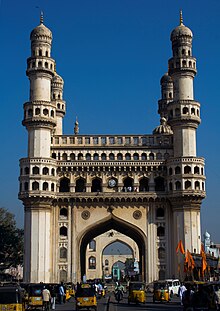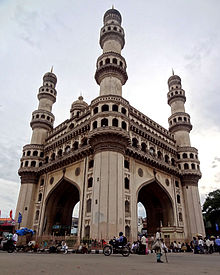Portal:Hyderabad
The Hyderabad Portal
Muhammad Quli Qutb Shah established Hyderabad in 1591 to extend the capital beyond the fortified Golconda. In 1687, the city was annexed by the Mughals. In 1724, Mughal Viceroy Nizam Asaf Jah I declared his sovereignty and founded the Asaf Jahi dynasty, also known as the Nizams. Hyderabad served as the imperial capital of the Asaf Jahis from 1769 to 1948. As capital of the princely state of Hyderabad, the city housed the British Residency and cantonment until Indian independence in 1947. Hyderabad was annexed by the Indian Union in 1948 and continued as a capital of Hyderabad State (1948–56). After the introduction of the States Reorganisation Act of 1956, Hyderabad was made the capital of the newly formed Andhra Pradesh. In 2014, Andhra Pradesh was bifurcated to form Telangana and Hyderabad became the joint capital of the two states with a transitional arrangement scheduled to end in 2024. Since 1956, the city has housed the winter office of the President of India.
Relics of the Qutb Shahi and Nizam rules remain visible today; the Charminar has come to symbolise the city. By the end of early modern era, the Mughal Empire declined in the Deccan and the Nizam's patronage had attracted men of letters from various parts of the world. The amalgamation of local and migrated artisans had originated a distinctive culture, and the city emerged as a significant centre of oriental culture. Painting, handicraft, jewellery, literature, dialect and clothing are prominent still today. Through its cuisine, the city is listed as a UNESCO creative city of gastronomy. The Telugu film industry based in the city was the country's second-largest producer of motion pictures .
Until the 19th century Hyderabad was known for the pearl industry and was nicknamed the "City of Pearls", and was the only Golconda Diamonds trading centre in the world. Many of the city's historical and traditional bazaars remain open. Hyderabad's central location between the Deccan Plateau and the Western Ghats, and industrialisation throughout the 20th century attracted major Indian research, manufacturing, educational and financial institutions. Since the 1990s, the city has emerged as an Indian hub of pharmaceuticals and biotechnology. The formation of special economic zones and HITEC City dedicated to information technology has encouraged leading multinationals to set up operations in Hyderabad. (Full article...)Selected article -
The culture of Hyderabad, also known as Hyderabadi Tehzeeb (حیدرآبادي تہذیب ) or Dakhini Tehzeeb (دکني تہذیب ), is the traditional cultural lifestyle of the Hyderabadi Muslims, and characterizes distinct linguistic and cultural traditions of North and South India, which meet and mingle in the city and erstwhile kingdom. This blending was the result of the geographic location of the region and the variety of historical dynasties that ruled the city across different periods—its inception by the Qutub Shahi dynasty in 1591 AD, the occupation by the Mughal Empire and its decline, and the patronage under the Asaf Jahi dynasty.
The city is historically known for its Ganga-Jamuni tehzeeb, which refers to unity and co-existence of Hindu and Muslim cultures and traditions. Apart from a few instances of communal violence, the majority of the city residents advocate communal harmony between Telugu people and Hyderabadi Muslims, the two main religious and cultural groups found in the city. (Full article...)General images
Related portals
Selected picture -
Categories
Did you know
WikiProjects
Topics
Wikimedia
Other Portals
Portals
This page was last updated at 2021-10-26 18:34 UTC. Update now. View original page.
All our content comes from Wikipedia and under the Creative Commons Attribution-ShareAlike License.































